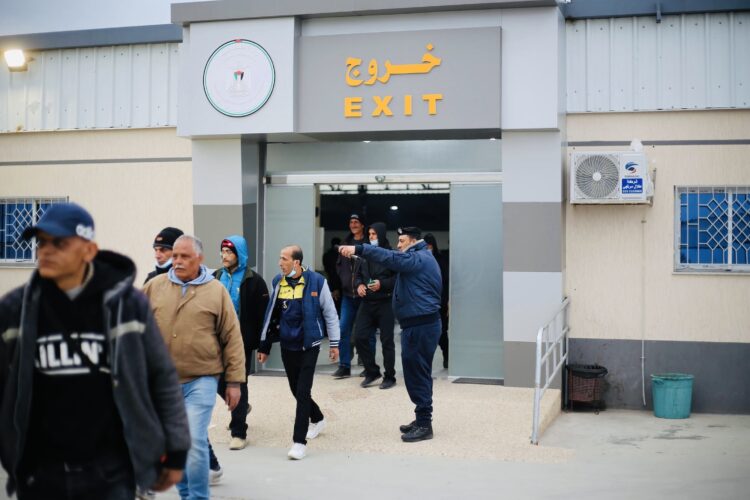As the war in the Gaza Strip drags on and approaches its fourth month, Israel faces an unsettling dilemma with major implications for its security.
Should skilled and unskilled Palestinian workers from the West Bank and Gaza be allowed to resume their jobs in Israel following the mass murder of 1,200 Israelis and foreigners by Hamas terrorists on October 7?
Prior to this unprecedented massacre, which led to the fifth Gaza war since 2008, 150,000 West Bank Palestinians and 18,500 Gazans had acquired Israeli government permits that enabled them to work inside Israel, mainly in agriculture and construction.
Apart from these workers, several thousand more Palestinians who had sneaked past the border worked in Israel illegally.
In the wake of October 7, the Israeli government cut off the flow of Palestinian workers into Israel and announced a plan to replace them with more than 80,000 foreign employees from Asia and Eastern Europe.
Israel imposed the ban for security reasons, but in doing so it created an acute labor shortage in the building industry and on farms that has slowed economic growth.

This shortage was exacerbated by three factors: the callup of some 300,000 military reservists to fight in the war, the evacuation of about 200,000 Israelis from southern and northern border areas, and the flight of thousands of foreign workers from Israel after October 7.

The problem revolving around Palestinian workers arose after some 3,000 Hamas terrorists poured into southern Israel, ruthlessly attacking a music festival, kibbutzim, border towns and army bases.
The marauders, particularly in settlements like Kfar Aza and Be’eri, were thoroughly familiar with their layouts and facilities. They knew exactly where to go to complete their murderous missions in as little time as possible and with maximum effect.
It is now clear that they owed their success, in part at least, to vital inside information about the places they intended to plunder.

By all accounts, they obtained the data from spies in plain sight — Gazans who had been employed there. At Hamas’ instructions, they memorized the layout of each site to be attacked, making it infinitely easier for terrorists to break past fences and barriers, locate key installations, and even fend off counter-attacks.
Only in retrospect did Israel come to the belated realization that lowly Palestinian day workers from Gaza had played an important role in Hamas’ success last October.
The lesson that has been learned since then can be applied to Jewish settlements in the West Bank and to towns and cities all over Israel, all of which employ Palestinian workers.

Each worker is vetted by the Shin Bet internal security agency before receiving a permit, but it is not a foolproof system. Although the vast majority of Palestinian workers are not terrorists and are simply interested in earning a living wage for themselves or their families, a very small number harbor malevolent intentions, an issue that Israel can ignore only at its peril.
Here is where Israel’s dilemma kicks in.
Since employment opportunities in the West Bank and Gaza are quite limited, Palestinians are often dependent on jobs in Israel, which pay a lot more. Absent these jobs, more Palestinians might well turn to terrorism.
But if Israel can provide them with steady work, they are far less likely to jeopardize their livelihoods, join terrorist organizations dedicated to Israel’s destruction, and carry out acts of terrorism.
In a recent cabinet meeting, Israeli government ministers discussed this pressing issue, but were unable to reach a consensus.
Prime Minister Benjamin Netanyahu and his allies were reportedly ready to vote for a proposal allowing some Palestinians to work in Israel.
Finance Minister Bezalel Smotrich and his supporters in the West Bank settlement movement voted against it, arguing that Palestinian laborers pose a real and present threat to Israel. Smotrich and his colleagues believe that Israelis should be encouraged to work on farms and at construction sites, and that new technologies should be used to reduce the number of employees required in these fields.
With Netanyahu and Smotrich having reached an impasse, this unsolved problem is growing worse. As Eliyahu Revivo, the chairman of the Knesset’s foreign workers committee said recently, “Israel must decide whether it will be assisted by Palestinian hands or not.”

In the meantime, the Shin Bet has reportedly submitted a stopgap proposal to permit 8,000 to 10,000 Palestinians from the West Bank to return to their jobs in Israel after they have been thoroughly vetted.
According to Ynet, a pilot program would permit 5,000 workers from the West Bank to work inside Israel. After submitting to examinations at checkpoints, they would be strictly supervised while in the country. In all probability, they would not pose a security threat to Israel.
These measures, even if enacted, would not solve Israel’s problem. With a labor gap in Israel looming, the Israeli government is seriously thinking of importing 20,000 workers from China, 25,000 from Sri Lanka, 17,000 from India, 13,000 from Thailand and 6,000 from Moldova.
